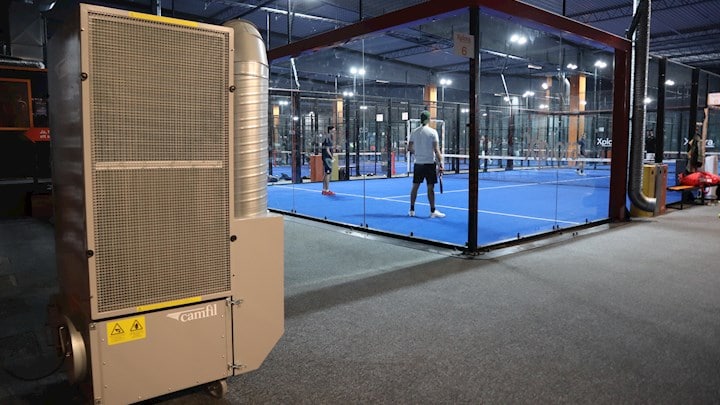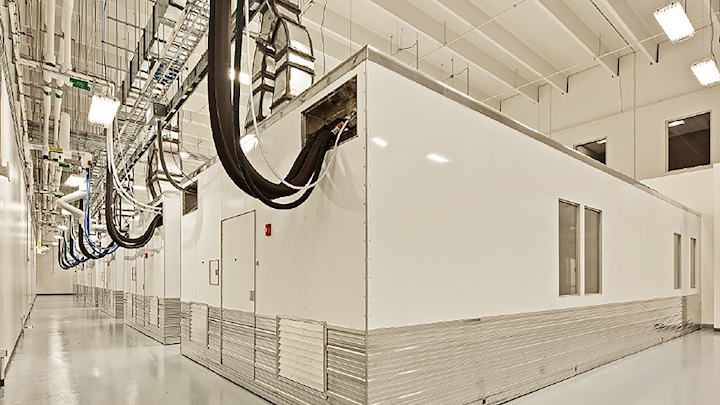
With its sina 22 indoor and 6 outdoor courts, PDL at Frihamnen is one of Europe's biggest padel center providers. . Previously an industrial center with different activities, the padel courts ventilation had to be adapted for padel and its 10 000 visotors a week.
Commercial and public buildings Case studies Air cleaners and air purifiers
G-CON Manufacturing, a mobile cleanroom provider, and Camfil recently partnered to provide their leading-edge technologies together to meet the needs of a well-known pharmaceutical customer.
Case studies Life science and healthcareMore than 100,000 Valencian students and teachers are now protected against biological agents such as SARS-CoV-2 thanks to our “City M” air purifiers. Camfil HEPA H14 filters are certified according to EN1822 standard and are delivered with their mandatory individual scan test certificate.
Hi-Flo bag air filters and CamGT EPA air filter upgrade reduces compressor efficiency degradation by 80%, slashes 3 offline filter replacements, 7 online pre-filter replacements, and 3 offline water washes per year.
CamPure 32 is the new ideal Camfil media for the removal of hydrogen sulfide during the production of biogas in an anaerobic process. Learn how this farm in France applied the high quality chemical absorbent media to their biogas application.
The tunnel can handle 5,4 million cubic metres of vehicle exhaust per hour and large tunnel exhaust passes air to 3 ventilation buildings along the tunnel section of the project.
Hinkley Point C in Somerset, United Kingdom is amongst the safest and most efficient nuclear power generator that is type of a Pressurised Water Reactor (PWR). With hundreds of megawatts electrical production in planning, safety of the process becomes a key concern.
Air filters help gyms stay fit for their visitors
Case Study: Dual 9 air filter. Higher performance, extended life (3-4 times longer), lower total cost and increased containment collection.
the technical service department at Deventer hospital received complaints several times a year about unwanted diesel odours in different parts of the hospital building. Headaches was one the key problem among the laboratory staff. In operating rooms, the problem was significant because the air is circulated directly from the exhaust vent onto the operating table.
Fast food stores are usually located in a crowded commercial area or building where there are problems such as polluted air, gases, and odours. The fresh air fan units in the ventilation system are often close to the pollution source, i.e., exhaust air of other shops in the building.
GO fit Sports Centers were forced to close all its centers in March 2020 when the state of emergency was announced in Spain to tackle the COVID-19 pandemic. Ingesport Group the parent company of the GO fit brand, contacted us to provide a comprehensive solution to reduce the risks of airborne transmission and infection, facilitating a safer indoor environment.
Premium air filters help global grocer significantly improve air quality and reduce maintenance costs, waste and storage
Egat North, the largest energy producer in Thailand, upgraded to Hi-Flo and CamClose air intake pre-filters as well as CamGT final EPA air filters and lowered degradation by 70%, reduced water wash requirements, and saved approximately $1.24M USD per year.
Frequent pressure and short filter replacement intervals led to high operational costs. Camfil's Cam-Flo air intake pre-filters and CamGT EPA air filters met their goal of 8000 hours of life and reduced pressure drop by 50%.
Air sampling, CamLab on-site analysis, as well as a Life Cycle Cost analysis show that the CamGT EPA filters will result in no shutdowns for turbine water washes, final filter shutdown extended to 5 years, decreased risk of corrosion and maximum power output.
An energy plant on the pacific coast upgrades their Siemens 501F gas turbine filtration to the CamGT 4V-300 air intake filters after tests show its water and salt handling capabilities.
Located offshore Ivory Coast, Africa, the CamGT EPA filter solution saves Foxtrot International 3 shutdowns per year and eliminates salt corrrosion, without compromising on footprint.
CamGT 3V-600 static final filters and Cam-Flo GT Hybrid pocket air filters eliminate 6 offline washes per year, improve gas turbine compressor efficiency, and boost power output for a Singaporean coastal cogeneration power plant.
Thomann GmbH is the world's largest online and mail order retailer in the music industry for musical instruments, light and sound equipment, with almost 10 million customers in 120 countries and 80,000 products on offer. Due to the daily stock turnover, a lot of dust is generated in the ambient air. This is also a concern with occupational health and safety.
In the meat processing industry, there is a big focus on ventilation technology for the prevention of the virus outbreak. Due to a lack of standards in the industry around ventilation, there is very little guidance around what should be considered as the clean air requirements for the facility.
A side by side comparison shows the benefits of higher grade GTC F9 gas turbine air intake filters for two RB211 gas turbines, even in very clean rural areas. It means a cleaner engine, higher power output, fewer water washes, and fuel savings.
The Watson Cogeneration Plant operates 4 GE, Frame 7EA engines and produces 400 MW for local refineries and sells excess electricity to the grid. The Plant Manager requested air intake efficiency, pressure drop, and water tests from Camfil. The test results revealed the true impact of the synthetic cartridge filters on gas turbine performance.
Purifying the air and protecting barber shop and salon customers - Effects of Covid-19
Dance Studios - Improving the air quality and protecting teachers and students
Tata Power Ltd, India's largest integrated power company requests Camfil for a Cam-Flo pocket bag filter and CamGT static air filter retrofit after heavy hot corrosion in the gas turbine and high pressure drop jeopardized performance and safety.
Case Study: Air Cleaner Solves Health & Dust Issue. The DB Schenker logistics centre in Önnestad, Sweden now successfully deploys Camfil CamCleaner 6000s for filtering and purifying air in hall areas. Commissioning the CamCleaners did not require major structural alterations.
Dalkia, a leader in the French gas turbine market, launched a national comparative test for various air intake filters, including Camfil's Hi-Flo pre-filters and CamGT EPA filters, to increase power production for their 10 GE LM6000 gas turbines.
Case Study: Clean Air For Cofely United Kingdom. Cofely, a GDF Suez company, is one of the leading experts in energy, technology and facilities management services with business outsourcing. Camfil provides City air purifiers to improve IAQ.
Case Study: Protecting Family-Owned Auto Body Shop. With a reputation as the best in their area, the third generation, family-owned body shop rehabilitates the exterior of foreign and domestic vehicles as well as motorcycles, specialising in classic and specialty cars.
For several years, Hornsgatan has been designated Sweden's dirtiest street when it comes to air pollution. Hornsgatan is an exposed street when it comes to harmful particles in the air. How does this affect residents?